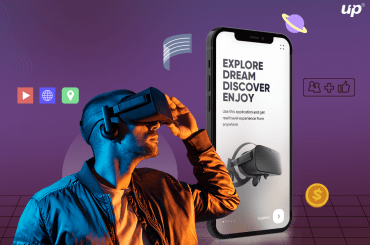Before we begin with the history of mobile apps, we must talk about some early mobile phones that paved way for mobile apps. The first ever hand-held mobile phone was launched by Motorola in 1973 weighing around 4.4 pounds (almost 2 Kgs). Later in 1983, Dyna TAC 8000 X became the first mobile that was sold commercially. Technology kept evolving and we started witnessing some astonishing handsets with various exciting capabilities. If you are thinking of when was the first smartphone invented, the term smartphone was coined in 1992 when IBM launched the first-ever smartphone in world but that hit markets in 1994.
Talking about the mobile apps, Nokia launched an in-built version of the basic arcade game “Snake” on its 6110 model in 1997. This is considered to be the first mobile app and following this trend, games like Pong, Tetris, and Tic-tac-Toe started flooding the mobile phones. Everyone would remember the Snake game where you need to control a line of dots that somehow looked like a snake after a while. However, these things were never called apps back then but were considered as a feature of the phone.
When Apps Were Not Too Fancy
In 2002, RIM lifted the concept of mobile apps with the launch of BlackBerry 5810 that was the first-ever phone to innovate the concept of wireless email. The apps used to appear in form of pre-loaded features of the phone such as games, ringtone editors, calculators, calendars, and to-do lists. All these features can be termed as ancestors of mobile apps.
The smartphone history witnessed a major turn when later in 2007, Apple released its first iPhone that changed the game of both mobile industry and mobile apps as well. This first iPhone came with some in-built apps like Maps, Photos, Text, and Weather. This was a revolutionary period in the history of mobile apps when with the launch of iPhone 3G, Apple also announced its plan to introduce a software development kit for mobile app development companies. iPhones started supporting third-party applications using the Safari engine on device.
The Launch of App Store

It was July 2008, when Apple launched its app store featuring more than 500 apps for iPhones. This grand slam by Apple helped it to gain 10 million downloads in just three days and the number of apps went to 800 native applications out of which more than 200 apps were offered for free. Later in 2010, the word “APP” became the word of the year declared by American Dialect Society. People started realizing the essence of mobile apps in their day-to-day lives and craze for mobile apps started flaming across the globe.
Google Launched Its Play Store

In 2012, Google initiated a major step towards bringing all its content under one single roof. Google Play Store was launched where mobile aps for Android phones were available for download. The concept started rebranding the Android market with Google Music, Google Books, and some of its video streaming services at one marketplace.
Till 2014, mobile apps became an indispensable part of people’s lives and all our gadgets including smartphones, iPhones, tablets, and PCs. There were also few apps which became a bigger hit on bigger screens. During this time, a Pictionary-inspired game gained 1 million users in just 9 days; a milestone that took more than 9 months for Facebook to achieve.
Apps that Created Buzz
During this transformative digital environment, there were certain apps that set examples for the world regarding usability and revenue generating potential of mobile apps. Apps like Candy Crush saga, Temple Run2, and ubiquitous Angry Birds dominated iOS users with seamless fun and excitement. Here are some names that set benchmarks in gaining popularity, revenue, and exhilarating downloads.
- NetFlix
- SnapChat
- Tik-Tok
- Amazon
- eBay
- Tinder
- Trip Uber
- Mint
- Grub Hub
Breaking the figure down, these apps proved to be the highest revenue generating mobile apps. Today, any mobile app development firm aims to develop a clone for these apps as each app dominates in its respective category.
Apps Started Making People Millionaire
Technological innovations paved way for better device hardware capabilities and with this, mobile app development industry evolved with some more sophisticated and unique concepts. Every business, irrespective of its size, is looking for an Android App development agency to launch business app. Facebook led the race by buying Instagram for 1 billion and most of the apps started making money with ads and in-app purchases. Even Snapchat got an acquisition offer for a whopping 3 billion but it simply refused it.
Skeuomorphism, 3d touch, and material design-mobile apps started witnessing all such concepts with constant focus on implementing latest technologies with them. Today, a mobile app development firm uses the best advanced tech stack to develop a customized app that can offer maximum convenience and flexibility to its users.
Wearable Apps
The concept of wearable device emerged long back in 1980s but its real potential was discovered few years back. Wearables were the fitness tracking watches that helped us monitor our heartbeats, pulse rate, water level, and many more health-related aspects. Today, we have an app for eating, drinking, exercising, shopping, paying, relaxing and what not. Tech startups started exploring heights of technologies and launched some innovative concepts through mobile apps to make people’s lives more convenient and hassle-free.
Today, there are more than 3.48 million apps available for download on Google Play Store while the Apple store also accounts for 2.24 million apps for iOS users. Mobile users demand more choices, opportunities, and customizations in mobile apps in the coming time that will be highly prioritized by any Android app development agency.










